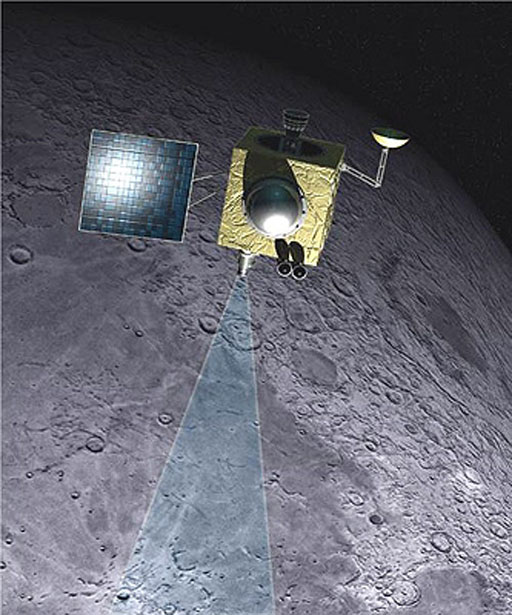[/caption]
Chandrayaan-1, India’s first unmanned spacecraft mission to moon, successfully entered lunar orbit on November 8. The spacecraft fired its engines to reduce velocity and enable the Moon’s gravity to capture it; engines were fired for 817 seconds when Chandrayaan-1 was about 500 km away from the moon. Next up for the spacecraft will be to reduce the height of its lunar orbit to about 100 km. Then, on Nov. 14th or 15th, the Moon Impact Probe (MIP) will be launched, and crash into the Moon’s surface (more about the MIP below). If you enjoy watching animations and want to see exactly how the spacecraft attained its lunar orbit, here’s a few animations for you:
A simple animation of how the spacecraft went from its spiraling elliptical orbit around Earth to its now spiraling elliptical orbit around the moon can be found on the India Space Agency’s site. (Sorry, the file was to big to insert here.)
Another quite large animation that was created by Doug Ellison (of UnmannedSpaceflight.com) shows how the X-ray Spectrometer aboard Chandrayaan-1 will work. This one takes a long time to download, but the wait is well worth it: the animation is spectacular.
Here’s a video that shows an animation of the entire mission; again, some great animation here. Enjoy.
The spacecraft is now orbiting the moon in an elliptical orbit that passes over the polar regions of the moon. The nearest point of this orbit (perigee) lies at a distance of about 504 km from the moon’s surface while the farthest point (apogee) lies at about 7502 km. Currently, Chandrayaan-1 takes about 11 hours to orbit the moon.
The MIP carries three instruments:
Radar Altimeter – measures the altitude of the probe during descent and for qualifying technologies for future landing missions.
Video Imaging System – acquires close range images of the surface of the Moon during descent. The video imaging system consists of analog CCD camera.
Mass Spectrometer measures the constituents of lunar atmosphere during descent.
Source: ISRO


BEGIN QUOTE
Mass Spectrometer measures the constituents of lunar atmosphere during descent.
END QUOTE
The ATMOSPHERE?
Congratulations INDIA … INDIA has now joined the G5 along with USA,Russia,Japan and China.. Its very proud being a part of this very diverse and yet wonderful country. As a proud citizen i shared the tense moments of the Lunar Orbital Insertion, which was the most important and tricky part of the whole mission. Now its all up to the team to lower the altitude to preplanned 100km circular orbit , before which it wil start sending some valuable information…! hopefully this will keep Indian and scientists world over busy for several years.. in battling the mysteries of our moon…. Cheers INDIA and ISRO
If I recall, the moon does have an atmosphere.
Only an inch or something, but it counts.
The moon has a thin atmosphere, mainly argon, some helium, a little methane, oxygen, nitrogen… and traces of carbon dioxide and monoxide – all together about 80000 atoms per cubic cm…. not much, but it’s there.
Wow. I feel dumb and enlightened at the same time.
Thank you, Maxwell and Feenixx.
The atmosphere of the moon was investigated by the early Mayans. They found that the atmosphere is mainly composed of dead gaseous spirits that smell of vanilla. The surface of the moon is coated in Mayan chocolate.
Early Mayan astronauts were celestial beings who moved easily between planets. They cultivated vanilla in large quantities to make a special kind of chocolate which they used for coating planets.
Have chocolate?
Wow. Its amazing how asian space races are catching up. I read somewhere that India is planning a manned mission to moon by 2015 if the budget gets passed in the parliament.
Yes, Indian is planning a manned mission by 2015 and in all probablity all the required funds will be available.
Some may debate that India is a developing country and that crores of rupees spent on such missions is unlogical. But I came through this article http://www.bharatchronicle.com/is-indias-moon-mission-really-worth-it which clrearly justifies India’s ventures into space.
This is a great day for India.
As to the future manned mission by 2015, I would be cautious here, as Chandrayaan-2 (involving a rover that will analyse the lunar soil, search for water vapour and deposits of Helium-3) is expected to launch by 2012, but before 2016.
Given that time-line above, a manned mission would, therefore, be several years down the line I would suspect, as there’s a big jump between getting a rover to the Moon and getting a man/woman there. I think we might see India getting a man/woman into orbit around Earth first — small steps at the beginning, then big one later.
John
http://www.moonposter.ie (A poster on important aspects about the Moon)
The following animation(Link mentioned below) is cool,and the music is great(sounds like our national anthem/Song) where it shows from milky galaxy to manned mission planned for 2014.Must watch animation!!
Government of India should start tours for travelling in space.
There are many rich people in the world who want to travel in space.
Thus funds can be generated through these tours and ISRO employees will remain busy for different active projects.
This will also give training to the people for travelling in space.
Obviously the selection of person/s for sending on moon will be easier.
P.J.LAKHAPATE
[email protected]
chandrayaan 1